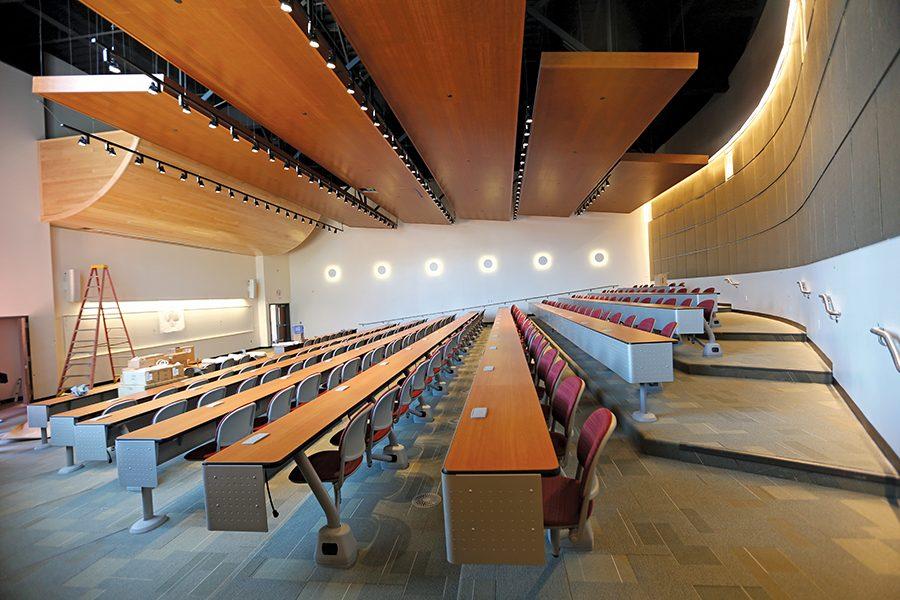Remote instruction raises logistical questions
The lecture hall in the General Education Building features a drop down projection screen and dwarfs the LA-100 lecture hall in size comparison.
May 3, 2020
On March 11, the Contra Costa Community College District issued a press release announcing the cancellation of events like the culinary arts department’s Food & Wine Event, the restriction of non-essential travel and a move to remote instruction through April 30.
Following the extension of statewide stay-at-home orders, the district shifted to remote instruction for the entirety of the spring semester.
The change to remote instruction is in line with what colleges around the country are doing to slow the spread of COVID-19 and ensure student safety, however, such a sudden shift to remote instruction has brought along a host of problems for Contra Costa College faculty and staff.
One major hurdle that arose during the change to remote instruction is basic logistics.
How will the classes be taught? Do teachers and students have the required equipment? How do instructors effectively teach remotely and how do students learn remotely?
The Distance Education Committee took a leadership role in providing resources and guidance to instructors making the shift to remote instruction.
Distance Education Coordinator Michael Kilivris said the weekend before the first day of remote instruction on March 13 the Distance Education Committee, Academic Senate and District college communities had a series of emergency meetings to plan the transition.
Maritez Apigo, campus instructional designer, set up a website with remote instruction resources provided by the expertise of the Distance Education Committee.
Resources included office hours from 9 a.m. to 9 p.m. for instructors with questions on remote instruction. The website also included a variety of instructional software and communication plans to keep students engaged and informed on their classes.
“I think many faculty are concerned about how to make this challenging transition in a technical sense, how to maintain the quality of their courses and how to continue equitably supporting students,” Kilivris said.
In addition to instructors receiving support, students also have significant resources available to aid their transition to remote learning. Remote tutoring is available for students by drop-in Monday-Thursday from 9 a.m. to 6 p.m. and appointment through the platforms Binom and NetTutor.
According to Tutoring Program Coordinator Brandy Gibson, it’s been a full effort to get the word out to students that tutoring resources are available remotely.
“We have been trying to get the word out to students since the campus closure but have been relying heavily on faculty to spread the word,” Gibson said. “We have sent announcements through Canvas, so students enrolled in ENGL-875N or MATH-875N could find out about the tutoring options. We’ve done a few social media posts, but those don’t seem to reach current students. We will have a targeted email campaign for students in math and science courses encouraging them to finish the semester strong by making an appointment with a tutor.”
According to Gibson, from the beginning of the campus closure through April 24, 175 students had signed up for the college’s Binom platform.
Additionally, 300 appointments have been booked and there were approximately 50 drop-in sessions.
Academic Senate President Katherine Krolikowski said a major concern was determining which lecture and lab classes could be completed remotely and if students will be able to learn what they need to in a remote environment.
Krolikowski said, “During the emergency our role was to determine if students could receive the full education they deserve, so when people finish classes, they get what they need — even if things are remote. Can a lecture class be completed adequately online? Before March 17, the Academic Senate said it’s possible for all lecture classes to be completed remotely. Then we (Academic Senate) thought about whether we were able to complete the lab classes remotely.”
Lab classes moving to remote instruction are faced with unique challenges because many lab classes are centered around hands-on learning.
Courses in automotive services, biotechnology and drama are going to struggle with the adaptation to online learning because of their reliance on working with equipment and gaining hands-on experience.
For Krolikowski’s Biological Sciences 157 class, there is concern that a lot of the future lab work will not be able to be completed due to the course moving to remote instruction.
Krolikowski said, “The first two remote lab meetings we were repeating techniques we’ve already done, so I had students guide me. I’m concerned going forward. What’s planned for this class is new things students are supposed to learn how to do in the lab. There’s a difference between watching something and doing it yourself. Our biotech classes are designed for students to do things themselves. Everyone has a good attitude, but the students also know they’re missing valuable experience in our facilities.”
Classes are being conducted primarily using Zoom and Canvas.
Zoom is an online video conferencing platform that allows classes to meet and discuss over video chat. Canvas is the common online learning platform used at Contra Costa College where instructors can assign assignments, create discussion boards, make announcements and post grades.
While these online learning platforms are not perfect according to Kilivris, they offer enough features for most lecture classes to be held in an effective manner. However, for these platforms, computers, webcams and other peripherals are often needed to create an effective learning environment.
Krolikowski said staff members were able to request equipment loans for webcams or computers. Biology professors were even offered white boards should they need to write formulas and illustrate demonstrations.



